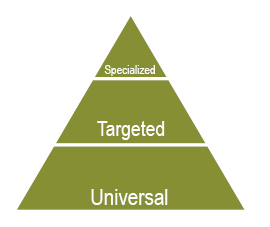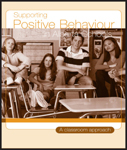
|
Universal Supports benefit all students
- Help students develop an understanding of the importance of getting and staying organized through class discussion, brainstorming benefits of being organized and modelling good classroom organization.
- Develop classroom routines that promote and facilitate getting and staying organized by providing step-by-step procedures for frequent classroom tasks, such as organizing materials and supplies, keeping organized notebooks and binders, recording homework and taking home what you need to complete assignments.
- Teach, practise and review these routines and strategies with students at beginning of school year and at regular intervals throughout the year. Model and practise each strategy. Start with one-to-three steps and gradually add more steps.
- Post visual reminders of
the importance of getting and staying organized. When appropriate,
collaborate with students to develop these visual reminders.
- Model the use of organizational strategies throughout the school day by using think alouds to direct students' attention (e.g., "I want to remind myself to ______ so I will make a note to myself on my to-do list.").
- Use descriptive feedback to reinforce individual students, groups of students and/or the whole class when they demonstrate organizational skills.
|
|

|
Targeted Supports benefit students with more specific needs
- Pair individual students with positive peers who can serve as role models and provide support for getting and staying organized. Rotate these peers at regular intervals throughout the school year.
- Provide proximity by positioning yourself nearby individual students who may require support and encouragement in organizing for certain tasks and activities.
- Work with individual students to develop low-key cues and prompts to remind the student to get or stay organized.
- Provide personalized visual checklists for routines related to getting and staying organized and post them on the students' desks where they can see and use them independently. Some students may wish to carry the checklists with them. When possible, include graphics or actual photos of students.
- Encourage the use of self-talk as students follow the checklists.
- Develop self-monitoring strategies students can use to reflect on and keep track of how well they are using their organizational skills and strategies.
- Set up a systematic approach to reinforcement for
students who are working on improving their organizational skills. Reinforcement
should encourage moving toward intrinsic motivation (e.g., "How does it feel
when …?").
|
Parents know their children well and can offer insights on how to support
their social and emotional well-being. There is strength in collaborating
on strategies that could be used at home, at school and in the community.
|

|
Specialized Supports benefit the small number of students with sensory, physical, cognitive or behavioural needs that require intensive, individualized interventions
- In exceptional cases, an individual student may need 1:1 adult support to facilitate participation in classroom routines, learning activities and social interactions with other students. This support should be provided as unobtrusively as possible. In addition, the adult providing this 1:1 should collaborate with the student's learning team to identify and facilitate how organizational skills and strategies might help this student experience increased levels of participation and independence throughout the school day.
|
|








